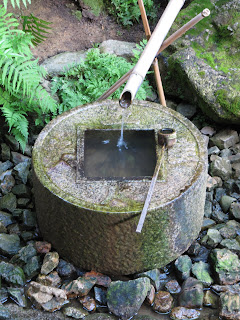We had a few more hours in Kyoto before we had to catch the Shinkansen back to Tokyo. Just enough time to see everything in Kyoto that we could not fit into the day before...


Ryoanji Temple, constructed at the end of the 15th century. An icon of Japanese culture, and likely the most recognized Zen garden in the world. The rock garden is made of white sand and 15 rocks, which are laid out such that all 15 rocks cannot be viewed at once from any vantage point in the temple.

The walls are made of clay boiled in oil. As time passed the unique patterns emerged as the oil seeped out of the wall, creating a one of a kind work of art.


Dad relaxes and ponders the significance of this garden



Everyone gives their theory on the meaning of the garden

The "tsukubai" or stone wash basin for the tea room. The inscription says "I learn only to be contented" which is important to Zen philosophy. It refers to one who learns only to be content possessing a rich spirit, whereas one who does not learn to be contented is spiritually poor even if materially wealthy.

Paul gets to ring the bell outside of Kinkakuji (the Golden Temple)

The top 2 floors of the Pavilion is actually covered in gold leaf

Having fun with photo settings


Paul and a group of students pose after they finish interviewing him


Mom & Dad pose in front of the Pavilion

Paul and another group of his fans

Mom gets in on the fun


A wishing garden? Not sure what to call it, but I did get a coin into the bowl on my first try. However, I failed miserably the next 5 times I tried to prove to everyone that I did.

Taking a little break before the next stop

Entry gate to Nijo Castle. We literally had just enough time to run through the castle before we had to get to the station to catch our train.

Ninomaru Palace is inside the first wall and moat, and was the primary building for receiving and entertaining guests, especially the feudal lords.

Everyone posing in front of Ninomaru Palace. I found the floors in this building to be the most interesting thing about it (unfortunately you are not able to take pictures inside - although a picture would not help explain the ingenuity). The floors in all the corridors are designed as "nightingale floors" which squeak like birds when someone walks on them to protect the occupants from sneak attacks and assassins.




The giant stone walls surrounding Honmaru Palace in the heart of the fortification. Outside of these massive walls is the second moat.

The main gate

Here comes the Shinkansen to take us back to Tokyo

Just enough time to drop off our bags, take a quick shower and then we are off to dinner with Aya's family, Abe-san, and the Watanabe's

The restaurant sent a shuttle to transport everyone to dinner

Campai!!! Tonight's dinner was arranged by Miyakoda-san and is on a boat that took us to Tokyo Bay.

A feast of sashimi, tempura, and all sorts of accompaniments.

All of the dinner boats in the bay, with the Rainbow Bridge in the background. As you can see the dinner boats are pretty popular in the warm months

The Odaiba entertainment district from the Bay

The dinner boats became popular in Tokyo prior to the introduction of air conditioning because it allowed people to escape the heat of the city even if only for a short time while they enjoyed dinner



Oh yeah Karaoke!!! You can't offer all you can drink without having a karaoke machine for people to enjoy once they have a few drinks


Eventually all good karaoke evolves into a dance party

And maybe a sumo tournament? Or is that a dance move?


I think they were celebrating finishing the bottle of whiskey. Abe-san was impressed with dad's "drinking strength." Of course he and Miyakoda-san are no lightweights themselves.

One last dance?

And of course no party is complete without a night cap on "Miyakoda-san's terrace". Actually it is at Gate City which is across from his house, but we have officially claimed it as ours and often enjoy dinner and a few drinks there when the weather is nice.
No comments:
Post a Comment